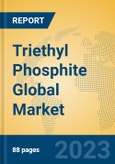Market Size and Growth Forecast
Research suggests the global Triethyl Phosphite market is estimated at USD 69 to 82 million in 2025, with a projected compound annual growth rate (CAGR) of 4.7% to 5.7% from 2025 to 2030, reaching approximately USD 92 to 112 million by 2030. This growth reflects robust demand from agrochemical and pharmaceutical applications, supported by industrial expansion, though moderated by niche market dynamics and regulatory constraints.Regional Analysis
- North America: Holds 25-30% market share, with a growth rate of 3-4%. The region’s growth is driven by a strong pharmaceutical sector and demand for specialty chemicals, with the United States leading in antibiotic synthesis and industrial applications, and Canada supporting niche chemical uses. The market benefits from advanced R&D infrastructure, though growth is tempered by regulatory oversight.
- Europe: Accounts for 20-25% market share, with a growth rate of 2-3%. Demand is steady in countries like Germany, Switzerland, and the UK, known for their pharmaceutical and chemical industries, with a focus on high-quality intermediates. Europe’s market is constrained by stringent environmental and safety regulations.
- Asia Pacific: Represents 40-45% market share, with the fastest growth rate of 5-6%. Growth is propelled by rapid agricultural expansion, agrochemical production, and industrial chemical demand, particularly in China, India, and Japan. China’s dominance in herbicide production and India’s growing pharmaceutical sector are key drivers, supported by large-scale manufacturing capabilities.
- Rest of the World: Holds 10-15% market share, growing at 3-4%, driven by emerging economies in Latin America and the Middle East, where agricultural and industrial growth boost demand. Brazil and South Africa see expansion due to agrochemical needs.
Application Analysis
The Triethyl Phosphite market is segmented by application, with estimated growth rates based on industry characteristics:
- Pharmaceutical: Expected to grow at 4-5%, used as an intermediate in synthesizing antibiotics like cephalosporins, with steady demand driven by healthcare needs and drug development. Trends focus on improving synthesis efficiency for complex medicinal compounds.
- Agrochemicals: Projected to grow at 5-6%, applied in producing herbicides like glufosinate, with higher growth reflecting global agricultural productivity demands. Trends emphasize sustainable and effective pest control solutions.
- Plasticizer: Expected to grow at 3-4%, used to enhance polymer flexibility and durability, with moderate demand driven by industrial manufacturing needs. Trends focus on expanding its use in specialty plastics.
- Fluorescent Brightener: Projected to grow at 2-3%, applied in whitening agents for textiles and daily chemicals, with steady demand reflecting niche consumer goods applications. Trends emphasize improving optical brightness in dyeing processes.
- Others: Including minor uses like chemical intermediates, expected to grow at 2-3%, with limited demand reflecting diverse applications. Development trends explore new industrial synthesis roles.
Key Market Players
Leading companies in the Triethyl Phosphite market include:
- Eastman: A global leader in specialty chemicals, offering Triethyl Phosphite for pharmaceutical and industrial applications.
- Hubei JinRuiJing: Specializes in organophosphorus compounds, providing Triethyl Phosphite for agrochemical and chemical synthesis.
- UPL: Focuses on agrochemical solutions, supplying Triethyl Phosphite for herbicide production.
Porter's Five Forces Analysis
The competitive dynamics of the Triethyl Phosphite market can be analyzed using the Porter Five Force Model:
- Threat of New Entrants: Medium, due to moderate barriers like technical expertise and capital costs, but niche market size and established players’ dominance limit new entrants, though opportunities in emerging markets exist.
- Threat of Substitutes: Medium, as alternative organophosphorus compounds or synthesis methods compete, particularly in cost-sensitive applications, but Triethyl Phosphite’s specific reactivity maintains its edge in key uses.
- Bargaining Power of Buyers: High, particularly from pharmaceutical and agrochemical firms that can negotiate pricing and demand alternatives, influencing market dynamics due to concentrated demand.
- Bargaining Power of Suppliers: Medium, with suppliers of phosphorus and ethyl precursors having some influence, but diversified sourcing reduces dependency risks.
- Competitive Rivalry: Moderate to high, among key players competing on quality, cost, and supply reliability, driving incremental advancements in production efficiency.
- Impact of Tariff Conflicts on Supply Chain Localization
Market Opportunities and Challenges
The Triethyl Phosphite market presents several opportunities and challenges that shape its future trajectory:Opportunities
- Increasing demand for agrochemicals, particularly herbicides like glufosinate, driven by global agricultural needs, boosting Triethyl Phosphite usage.
- Growing pharmaceutical sector, with steady demand for antibiotics and intermediates, supported by healthcare advancements, enhancing TEP applications.
- Expansion into emerging markets with rising industrial and agricultural activities, particularly in Asia Pacific and Latin America, where demand for specialty chemicals fuels growth.
Challenges
- Volatile raw material prices, particularly for phosphorus and ethylene derivatives, impacting production costs and profitability, requiring effective cost management.
- Regulatory pressures on chemical emissions and safety, raising compliance costs and pushing for greener alternatives, challenging traditional uses.
- Supply chain vulnerabilities due to tariff conflicts and reliance on global trade, necessitating robust sourcing and localization strategies.
This product will be delivered within 1-3 business days.
Table of Contents
Companies Mentioned
- Eastman
- Hubei JinRuiJing
- UPL








